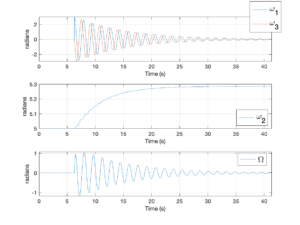I’ve been teaching the theory of nutation dampers for years, and have finally gotten around to creating a good visualization of one. Nutation dampers are really neat devices for rejecting disturbances on spin-stabilized spacecraft. Essentially, a damper is any mechanical device with energy dissipation that is excited by spin about a transverse spacecraft axis. The dissipation mechanism causes the non-symmetry axis spin to diminish over time, and the spacecraft returns to pure symmetry axis spin. Physical implementations can range from spring-mass-damper systems to wheels mounted on a transverse spacecraft axis whose spin results in any sort of viscous damping. Here’s an animation of the latter sort. The spacecraft (blue cylinder) is a major-axis spinner, and experiences an angular impulse after five revolutions, which spins up the nutation damper (red wheel). Over time, the spacecraft settles back into pure symmetry axis spin.
 The plots show the time histories of the components of spacecraft angular velocity (\omega_2 is the spin about the symmetry axis) as well as the damper’s spin rate (\Omega).
The plots show the time histories of the components of spacecraft angular velocity (\omega_2 is the spin about the symmetry axis) as well as the damper’s spin rate (\Omega).
Animation code at: https://github.com/dsavransky/MAE4060/blob/main/Animations/nutation_damper_animation.m and a full derivation can be found at: https://nbviewer.jupyter.org/github/dsavransky/MAE4060/blob/main/Notebooks/Viscous%20Nutation%20Damper.ipynb
